In 1980, it all started here…
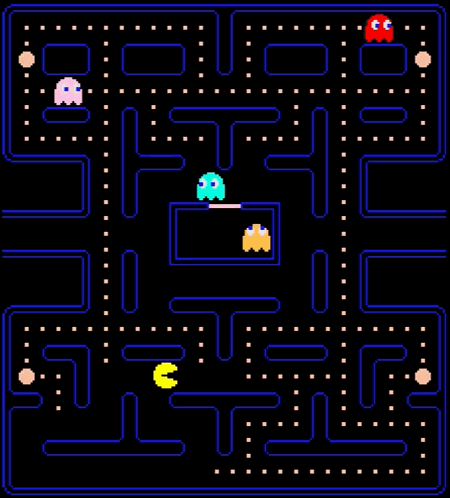
Pac-Man’s world fills one screen. However, if one were to visualize it in 3-D space, the maze exists on some manner of cylinder. Right from the beginning, the sides of the maze connected to each other. So a pac-maze is essentially a series of tubes. Meanwhile…
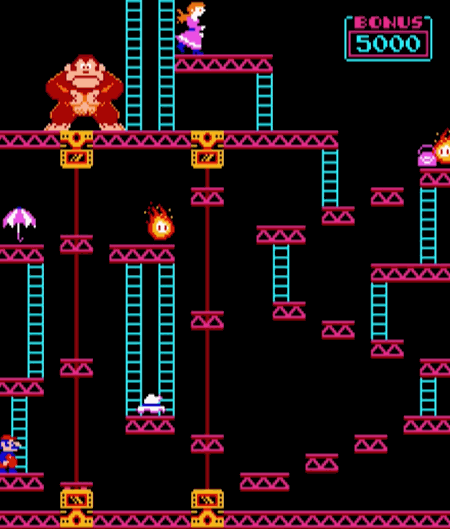
1981 gave us this familiar barrel of monkeys in Donkey Kong. Four screens of fun there, and every construction site or cement factory is a 2-D representation of a (narrow) 3-D space. No wraparound, just one 100-meter tower of power. Restarting at the bottom of the rectangle is not because of a geographical loop, but an endless cycle of gorilla violence. Though the tubes returned when…
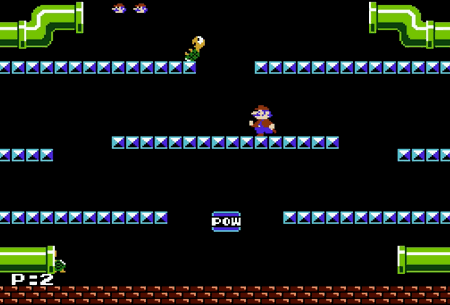
1983 saw the birth of Luigi, and a sewer system infested with turtles, crabs, and fireballs (?). Like Pac-Man, the Mario Brothers inhabited a single screen that looped at the edges. There were varying configurations of opponents (and the occasional bonus stage!). But, like over in pac-land, the cylindrical sewer could have been permanently painted onto the arcade cabinet. What came next?
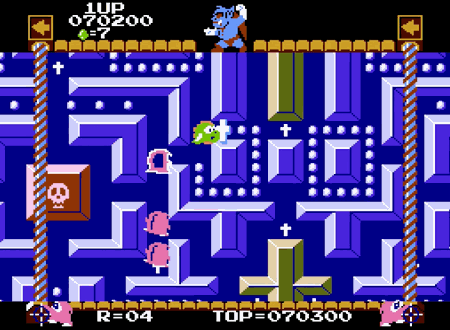
1984 gave us (well, Japan) this nonsense. A year before Super Mario Bros., it taught the children that entered Devil World a valuable lesson.
Prior to its release on the Nintendo Switch Online Nintendo Entertainment System Service in 2023, many Americans had only heard of Devil World in hushed whispers and rumors. It was a game by Shigeru Miyamoto, creator of Super Mario Bros., but its religious imagery was deemed too controversial for American audiences. And that assessment is correct! Your hero is some manner of winged dinosaur creature (fella looks like the offspring of Yoshi and Bub ‘n Bob), but your main opponent is the titular Devil. And, while that kind of thing was allowed in the 80’s with cartoony devils (looking square at my pal Firebrand at the moment), what was most certainly not allowed was Tamagon (hey, our protagonist has an official name) collecting crosses and bibles. Link can get away with that once, but straight up using religious iconography against the literal devil is forbidden. Devil World was banished to heathen PAL regions as a result, and America was left with agnostic titles like Donkey Kong Jr. Math. Just as well, really, as Devil World would have likely been ignored in the same way no one wistfully remembers Urban Champion or Ice Climbers.
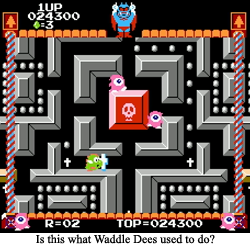 And, looking back from this far-flung future epoch of the 21st Century, it is clear that Devil World deserved better. The gimmick of Devil World is that we are dealing with a basic, Pac-Man-esque style maze world, but the boundaries of that maze move. This leads to three different threats:
And, looking back from this far-flung future epoch of the 21st Century, it is clear that Devil World deserved better. The gimmick of Devil World is that we are dealing with a basic, Pac-Man-esque style maze world, but the boundaries of that maze move. This leads to three different threats:
- You cannot always get where you want to go due to moving boundaries
- You cannot always avoid an opponent due to moving boundaries
- You may be squished into oblivion by the moving boundary
And, while the first two issues could be accomplished by gates or some other nonsense that may have been explored in Super Pac-Man, the squishing-boundary is exceptional. And that Devil that presides over Devil World controls this homicidal border. So it is no wonder this entire game forsook Tamagon and identified The Devil as the titular character. He deserves it! He is teaching players about the dangers of screen borders!
We take it for granted now, but “the screen” was something that had to be learned in the infancy of gaming. The examples at the top of this article all had different takes on how your gameplay area worked, and booting up a new game meant learning a new kind of geography. If you played Space Invaders, you had a little square of area to defend. If you played Asteroids, you and the space rocks both were free to loop around the edges. Devil World was right on the cusp of games where “the screen” could move with your player avatar smoothly. No more would we have to deal with a gigantic(ish) world like Pitfall where traversing every area felt less like a world and more like a patchwork quilt. Now Mario would be able to seamlessly go from castle to castle. Only a goomba could stop him now!
… Well, unless he wanted to go backwards…
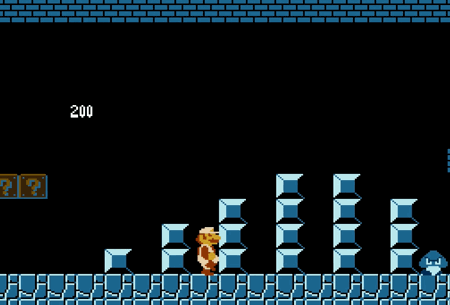
Scrolling or not, “the screen” was always going to be a factor. The Super Mario of 1985 could never retreat. This created problems both small (you missed that powerup!) and large (there is a reason we have never seen those stupid looping fortress stages again). Super Mario Bros 2 created worlds that could be explored frontwards and backwards in 1988 (1987 if you Panic)…
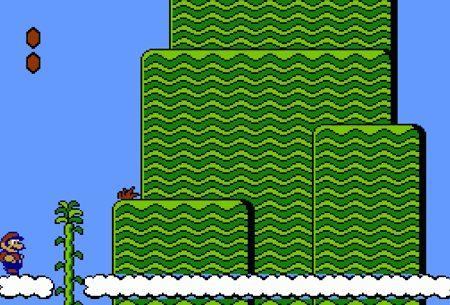
… Super Mario Bros. 2 felt like we were free of the reign of terror of “the screen”. Give or take being locked out of that freaky shadow world with the cool music due to a timer, we had complete freedom to steer Mario wherever we wanted.
And then, in 1988, the Devil returned.
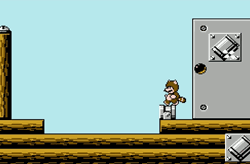
“The screen” is back, and it is angry.
There are many “auto scrolling” or “belt” stages in Super Mario Bros. 3. It all starts at 1-4 (a level that is easily skippable if it seems like too much for a neophyte player), but every airship and tank from here to Bowser’s castle includes an automatic scroll, too. One of the scariest stages in SMB3 is an underwater, automatically scrolling maze of electric jellyfish, and belted chokepoints like that are practically the reason Mario ever needs a Lakitu’s Cloud. But if you were to remove the scroll from these stages…
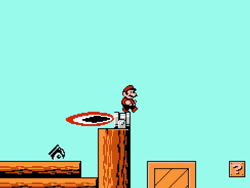
You find they ain’t no thang. Airships become basic obstacle courses no different than running around the grasslands, and even a submerged electrocution maze is easily navigated when you can take your time. Drop the scroll, and a deadly King of the Koopas becomes a hapless turtle.
That is the secret of a wild, deadly scroll. When the player has lost control of the screen’s focal point, there is conflict. An automatic scroll makes you the victim of your own POV, and you must adapt or die. You are not in control, and if you do not quickly adapt to this intractable emperor, you will be put to death.
Why, you may as well be dealing with a world ruled by the devil.
The first Nintendo game that introduced a “malevolent” viewpoint deliberately included a character that explained why you had to deal with this lethal nonsense. Nobody likes the devil! He’s the devil! And America missed this explanatory step. More’s the pity. Now, nearly forty years later, the best we can get are some plants controlling your screen…
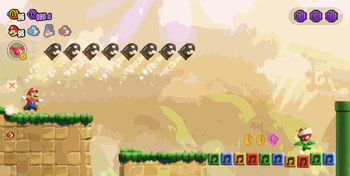
The devil really deserved his due.
SBC #25 Devil and Devil World
Devil in Super Smash Bros Ultimate
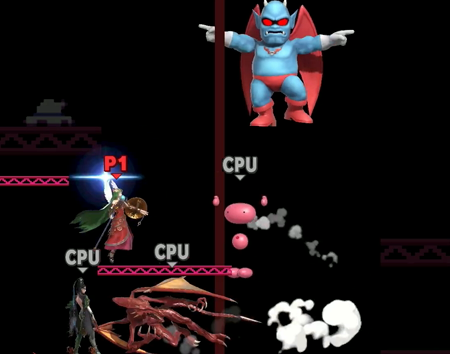
- What Am I Looking At? We are getting 100 articles out of this Smash Bros. Challenge, but there are not quite 100 different playable characters in Super Smash Bros. Ultimate. So we are looking at a few notable assist trophies to fill out the ranks. Devil seems like a good place to start, as he is not represented in any other capacity across… uh… anything. Can a brother even score a cameo in WarioWare?
- Happy to see him? Like all assist trophies, Devil’s appearance is completely random. And when he does appear… well, he is not very helpful. Some assist trophies will slaughter your enemies. This assist trophy shuffles the screen regardless of your wants, and may straight up murder his summoner. Appropriate for the Devil to be such an unmanageable nuisance, but it means I cannot give him a glowing performance review.
- Does he literally work? Devil jiggling the screen around only works on stages where there is already no automatic scrolling, and a layout that can accommodate everyone being squished over to a side. So that means that Devil cannot be summoned on 69 (nice) stages across Super Smash Bros. Ultimate. 60% of the game! He is free to reign over any battlefield stage, though.
- Ever fight ‘em? Devil is an opponent in Adventure Mode. He appears on the battlefield version of 75m, and possesses Ridley to utilize a playable body. And that’s great! Ridley is absolutely the closest thing to a devil on the roster (he did eat Sammy’s parents), and he is a representative of the 8-bit days, too. Way to pick ‘em, Devil!
- The background work? 75m is his stage in Adventure Mode, so let’s go with that. I despise this stage. I appreciate what is happening here (it’s a whole ass level from Donkey Kong!), but the lack of a floor and so many platforms… ugh. And springs! I hate springs! I wish for a world with no springs!
- Smash Trivia: Devil is mentioned in the description of his rival Tamagon’s trophy in Super Smash Bros. Melee. Of course, that trophy was only legitimately available in Japan, so America once again missed out on meeting this monster.
- Does Smash Bros Remember Today’s Game? Devil was one of the first assist trophies introduced back in Super Smash Bros. Brawl, and it is debatable if anyone in America would have ever heard of Devil World without that feature. Past that? Devil may return for multiple Smash games, but his contemporaries have never appeared, and he doesn’t seem to have a stage or theme to his unholy name. Sad but appropriate: another situation where he got the ball rolling, but was then ignored by future generations.
Devil in Devil World
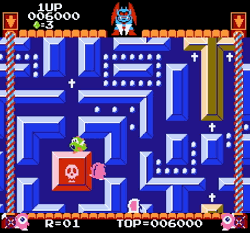 System: Nintendo Entertainment System. Well, Famicom, technically. It appears this is not one of those early Nintendo games that had an arcade counterpart. In fact, this is Miyamoto’s first console-only title. He would be responsible for a few more of those over the years.
System: Nintendo Entertainment System. Well, Famicom, technically. It appears this is not one of those early Nintendo games that had an arcade counterpart. In fact, this is Miyamoto’s first console-only title. He would be responsible for a few more of those over the years.- Number of players: Two player alternating. Unlike Luigi, Tamagon’s player two does not technically exist.
- Secret Origins: Tamagon blasts opponents with Bible firepower, and then the opposing monsters appear to become eyeballs not unlike the Pac-Man ghosts. But Tamagon has a leg up on his yellow contemporary, as he can devour partially defeated rivals. So this is another weird little detail that points to Tamagon being an evolutionary ancestor of the modern (and hungry) Yoshi.
- Devil’s Drip: The decision to clad the devil in exclusively boots and a banana hammock is unexplained.
- It is not polite: To be clear, the screen always moves in the opposite direction from where Devil points. This is consistent in Devil World and Smash Bros. It is hard to determine if this means that the Devil’s helpers are terrible, or if Devil is in some manner of mirror existence. Whatever the case, do not trust the Devil.
- Actual Bonus: The bonus stages have arrows on the floor so you may control the maze borders in the devil’s absence. This would be empowering if not for the fact that bonus stages are extremely time-limited, and boy oh boy are you going to get squished by a wall anyway. Even when the Devil isn’t home, living in the Devil’s World ain’t easy.
- Did you know? In Tetris DS, Devil World is one of the backgrounds that will appear at around 170 lines. The next successive background is based on Urban Champion. The implication here is that you graduate from Devil World to Urban Champion even though no one in history has ever seen Urban Champion as a reward for anything.
- Would I play again: Devil World is best described as “a fun little arcade game” (even if it never saw an arcade). That said, it is extremely limited, and, by virtue of being on the Nintendo Online Service, it must compete with Super Mario Bros. 3 for my eyeballs. So will I play it again? Not today, Satan.
What’s next? We cannot get enough of mazes, so we are bringing Pac-Man to this party. Please look forward to it!
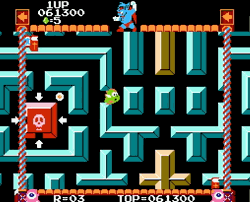
I admit it, this kind of thing would have scared me as a child.